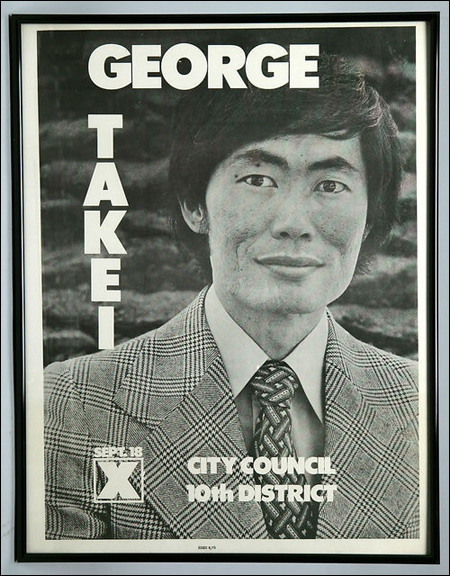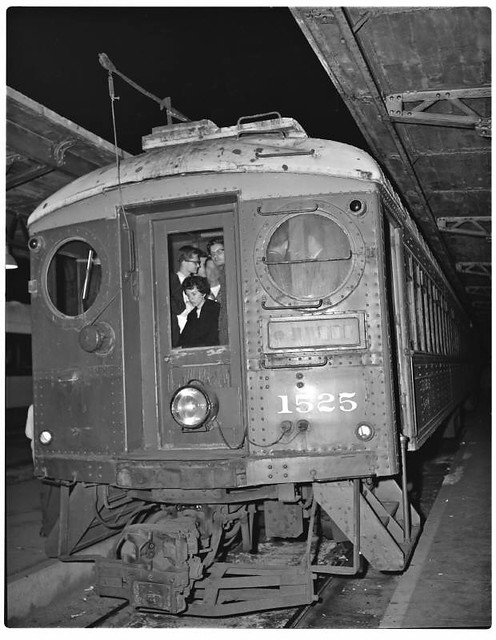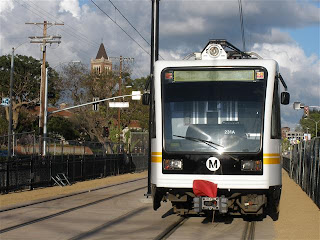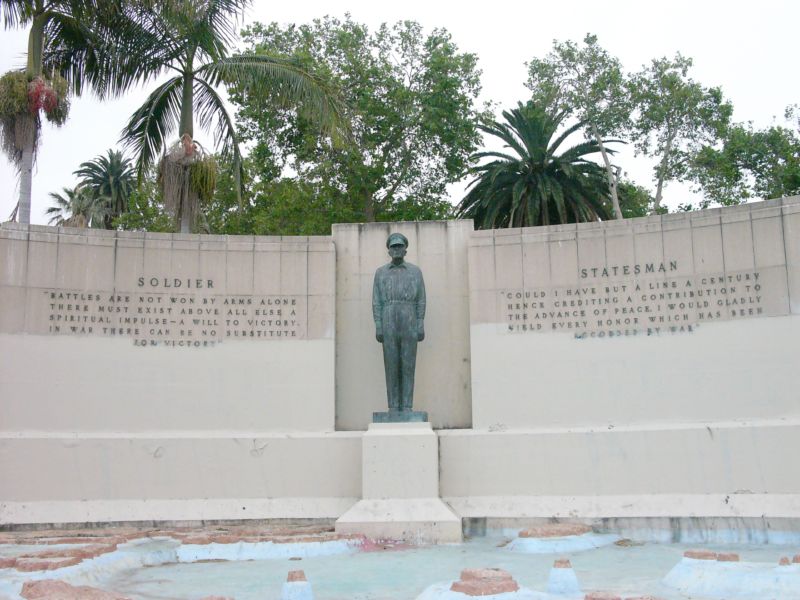
As you may or may not know,
CicLAvia is returning to Los Angeles streets this Sunday, April 10, from 10 a.m. to 3 p.m. Y'all gonna be there, right?
The last time around, The Militant biked the entire 7.3 mile route in a state of ultimate euphoria, experiencing an awesomeness never felt before. This time, The Militant admits, that while it will still be incredibly awesome to enjoy seven miles of Los Angeles streets without cars for five hours, the novelty would have worn off just a little.
But The Militant knows how to keep it fresh! This time around, you're gonna see the CicLAvia route like you've never seen it before! Several days ago, he read
this Huffington Post entry on "10 Historic Buildings" along the route. But he was a little disappointed to see history end at the Park Plaza Hotel. Is that how far history goes? C'mon now! So he made his own list -
nearly 3 times larger!
The Militant has compiled a list of historic, significant, interesting and little-known spots along (or not very far from) the route, designed to increase your militant knowledge of Los Angeles! Just follow this guide (The Militant recommends you print it out) and you'll be on your way! By late Sunday afternoon, most of you would appreciate this City much more than you already do now!
So let's go, yo!
View The Militant Angeleno's CicLAvia Tour! in a larger map
Note: Though The Militant likes to view the route from west to east for some reason, he has listed these sites from East to West, as some of the sites are related and make a little more sense when going that direction.
 1. Hollenbeck Park
1. Hollenbeck Park1892
4
th and St. Louis streets, Boyle Heights
John Edward Hollenbeck was a rich dude in the late 19
th century who founded the First National Bank of Los Angeles (more on this later) and purchased parcels of land in Downtown, the San Gabriel Valley and the Eastside, where he made his home. Hollenbeck was also credited with the creation of what is now called
Exposition Park. His sister married his friend, James George Bell, who founded...
Yep, you guessed it! After Hollenbeck's death in 1885, his widow, Elizabeth, donated a 21-acre parcel of land, which was essentially their front yard, to the City.
One of the Los Angeles’ oldest parks, it was established in 1892 and continues to function today.
2. Hollenbeck Palms (Site of the Hollenbeck Residence)1896
573 S. Boyle Ave, Boyle Heights
Take a quick detour from the CicLAvia route on 4th street and head down Boyle Ave a block and a half south.
On the site of this retirement facility, which directly dates back to the Hollenbecks' involvement, John and Elizabeth Hollenbeck made their home. The original Hollenbeck residence had a room built for the care of John's elderly father. After John's death, Elizabeth donated land she owned across the street (since visually separated from Boyle Ave in the 1950s due to construction of the 5 Freeway) for Hollenbeck Park and, in another act of philanthropy, created the
Hollenbeck Home for The Aged on her property in 1896, offering free board and care for the residents for the rest of their lives. After Elizabeth's death in 1918, the Hollenbeck Trust operated the elderly home (modernized in 1985), and continue to run it today.
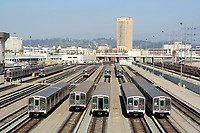 3. Metro Division 20 subway car yard
3. Metro Division 20 subway car yard1992
320 S. Santa Fe Ave (visible from
the 4th Street Viaduct), Arts District
Take a break from riding/walking/skateboarding/pogo-sticking/etc. and take a glance off the north side of the bridge from the west bank of the River. This facility is where the 104
Italian-built subway cars of the Metro Red and Purple line cars are stored, repaired, serviced and cleaned. This was also the temporary storage and repair site of the Angels Flight railway cars after the fateful 2001 accident. The Militant actually visited this facility back in May 1992.
4. Site of Quaker Dairy, Original Little Tokyo Restaurant
1890
304 E. 1st St., Little Tokyo
On the southeast corner of 1st and San Pedro streets once stood the Quaker Dairy, a restaurant started on this site in 1890 by Sanshichi Akita, an immigrant from Japan. Though preceded five years earlier by another restaurant on First St (location unknown), this is the oldest traceable location of a Little Tokyo business. By the end of the 19th century, there were over 16 Japanese-owned restaurants in this stretch of 1st Street, creating what we know as Little Tokyo.
 5. Los Angeles Sister Cities Monument
5. Los Angeles Sister Cities MonumentCirca late 1980s
1st and Main streets, Downtown
On the northeast corner of 1st and Main streets stands a pole bearing signs (in the "Blue Blade" style, no less) for every one of Los Angeles' 25
Sister Cities, each pointing towards their location. The signs range from
Lusaka, Zambia (the farthest sister city, 10,017 miles) to
Vancouver, Canada (the nearest, 1,081 miles) and everywhere in between.
Nagoya, Japan is Los Angeles' oldest sister city (1959);
Yerevan, Armenia is the newest (2007). Los Angeles, an Olympic host city (1932, 1984) also has that in common with sister cities Athens (1896, 2004), Berlin (1936), Mexico City (1968) and Vancouver (2010). Okay, the Militant is just filling up this paragraph with mindless trivia.
6. New Los Angeles City "Chevy Logo" Street Signs2009
Various locations along 1st Street, Downtown
Speaking of Blue Blades, and since you're on 1st Street, don't forget to see
Los Angeles' new street signs! Featuring a reflective background and typeface,
the City Seal and shaped like the Chevrolet logo, these were the subject of
The Militant's now-legendary recent post on Los Angeles street signs. Now you can see them for yourself!
7. Los Angeles Police Administration Building2009
100 W. 1st St.
Having opened less than two years ago, there's nothing really historic about this building, but do stop and take a picture of City Hall's reflection from the facade's glass panel. It's like, the thing to do.
 8. Old State Office Building Foundation
8. Old State Office Building Foundation1931 (Demolished 1971)
1st and Spring streets, Downtown
Ever wonder about that park-like area across the street from City Hall, and why there appears to be a foundation but no building? It was once the site of the State Office Building (pictured left, looking north on Spring), which was built in 1931. Forty years later, the 6.4 Sylmar Earthquake rendered it unsafe, and it was demolished. The land was once an openly-accessible parkspace; the Militant remembers going to a demonstration there as a child (Oh this Militant stuff sure started early...)
 9. Site of the Wilcox Building, First National Bank
9. Site of the Wilcox Building, First National Bank1896
2nd and Spring streets, Downtown
Remember Mr. Hollenbeck? He be makin' serious bank! Oh wait, he literally did. As was mentioned, he founded a bank called the First National Bank of Los Angeles, which made its original home here on the southeast corner of 2nd and Spring in what once stood the Wilcox Building. Check this out: First National Bank merged with the
Farmers and Merchants Bank to become the Security-First National Bank, which became
Security Pacific National Bank (1967), and was eventually purchased by
Bank of America in the 199os.
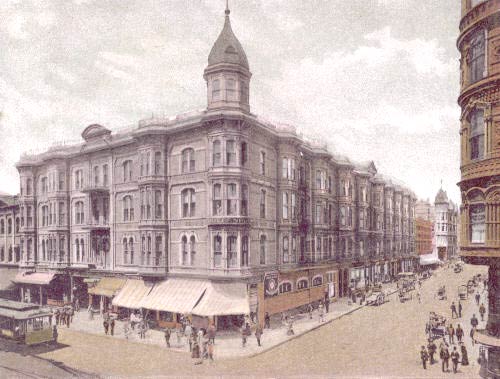 10. Site of Hollenbeck Hotel
10. Site of Hollenbeck Hotel1884
2nd and Spring streets, Downtown
Man, this Hollenbeck dude got around! We're not quite through with him yet. Directly across Spring Street from the bank (on what is now a parking lot) stood the Hollenbeck Hotel, a pretty swanky, bougie inn back in the day. He owned not just the hotel, the entire block the hotel stood on (He sooo money!). As more hotels were being built in Downtown, this one eventually lost ground to its competitors and was demolished in 1933.
 11. Site of Original Ralphs Supermarket
11. Site of Original Ralphs Supermarket1873
6th and Spring streets, Downtown
Before the Hotel Hayward building was built in 1805, George A. Ralphs (see, that's why there's no apostrophe) and his brother Walter B. started the Ralphs Bros. Grocers on the southwest corner of 6th and Spring.
Their company still continues to this day, and in 2007, the company that started in DTLA
returned to the area after some 50 years.
12. St. Vincent Court1868
St. Vincent Ct and 7th Street, Downtown
You'd hardly knew it was there, but this alley nestled between Broadway and Hill (blink and you'll miss it!), with its decorative brick pavement and European decor, seemingly belongs to another world. Originally the site of a Catholic college that was
the predecessor of today's Loyola Marymount University, today it's a unique food court featuring Armenian and Middle Eastern eateries. The Militant calls it, "Littler Armenia."
Check out this Militant Angeleno post on St. Vincent Court from 2008 for more info!13. Wilshire Grand Hotel1952
7th and Figueroa streets, Downtown
What we see today as the
Wilshire Grand Hotel is the latest in a long lineage of hotels that operated from that building. Originally built as the Los Angeles
Statler Hotel (one of a dozen nationwide in that chain) in 1952, it became the Statler Hilton, then the Los Angeles Hilton, then the Omni Los Angeles Hotel, and finally the Wilshire Grand. Take a good look at this hotel, though - the hotel's owner, Korean Air Lines, plans to demolish it and put up
a big-ass hotel with
crazy-ass LED advertisements on the building in the next few years.
 14. City View Lofts/Young's Market Company Building
14. City View Lofts/Young's Market Company Building1924
1610 w. 7th St., Pico-Union
Ever wondered what's the deal with this 4-story Italian Renaissance-style building? It was built in 1924 as a liquor warehouse and original headquarters for Young's Market Company, which
still operates today as the largest liquor distributor in the West. This building features actual marble columns and a decorative frieze made of terra cotta. The company, in the roaring, pre-depression 1920s, just felt like it. The building was looted and burned in the 1992 Riots and was rehabbed in 1997 to become the
City View lofts. The building is in the
National Register of Historic Places.
 16. Gen. Harrison Gray Otis Statue
16. Gen. Harrison Gray Otis Statue1920
Northeast corner of Wilshire and Park View, Westlake
Gen. Otis is perhaps the most visible statue at the park, which predates MacArthur's WWII service. This general served in the Spanish-American and Philippine-American wars, and also fought as a Union soldier in the Civil War. But in Los Angeles, he is most known for being the founder, owner and publisher of the
Los Angeles Times.
So why is he here? His Wilshire Blvd mansion, called The Bivouac, was located across the street, was later donated to Los Angeles County and became the original campus of
Otis Art Institute. It's thought that his statue is pointing to the site of the Elks Lodge, but he's probably just pointing to his old house.
17. Nob Hill Towers/Old Nob Hillc. Early 1900s
Ocean View Ave. and Carondelet St., Westlake
18. Can You Really See The Ocean?Present Day
Ocean View Ave. and Park View St., Westlake
Allow yourself to veer off the CicLAvia route for a bit - From 6th St, head north on Coronado St for a few yards and make a right on Ocean View Ave to view a couple places covered in the Militant's
January 2011 blog post on ritzy old Westlake.
On Ocean View and Carondelet, you'll find the Nob Hill Towers, the last vestige of what used to be known as Los Angeles' "Nob Hill." Bike up another block to Park View St, and if the sky is clear, look to the south and see if you can see the sea. On a clear day, you can see Catalina Island, for sure. If all else fails, you can still see the park, lol.
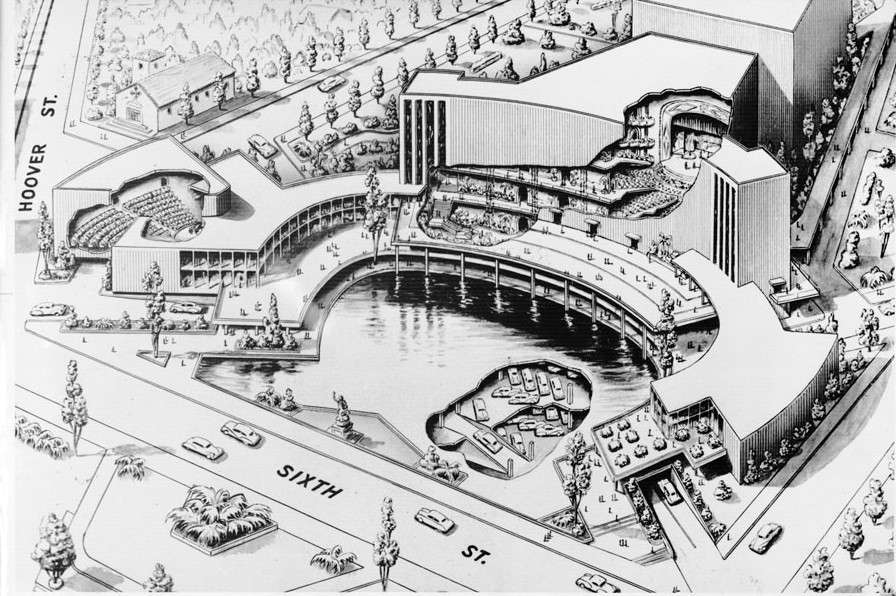 19. Formerly-Proposed Site of the Music Center
19. Formerly-Proposed Site of the Music Center1950 (never built)
6th and Hoover streets, Westlake
Believe it or not, in 1950
there was a plan afloat to build a music and fine arts performance facility in Los Angeles...but not in Downtown. This proposal, complete with a concert hall, a theater,
a man-made lake and several levels of underground car parking, was to have it located along 6th Street between Hoover Street and Lafayette Park Place. Sounds like a certain county supervisor at the time might have lived in the neighborhood. The Militant is soooo glad this didn't materialize. Some things were just never meant to be.
 20. Occidental Parkway
20. Occidental Parkwayc. 1920s
Occidental Blvd between Hoover and Beverly, Westlake
Also covered in
the Militant's post on old Westlake is Occidental Parkway, which is
actually part of the City's park system. The palm-lined street with a median will take you northward to Beverly Blvd (If you're down for an
Original Tommy's burger, head east on Beverly for a few blocks).
21. Visible Yellow Car Trolley Tracks (6th Street)
c. 1910s
6th Street and Commonwealth Ave
Look carefully through the paving in the middle of the street (west side of the intersection); you might just see a pair of 3 1/2-foot wide trolley tracks, once used by the
3 Line of the Los Angeles Railway's Yellow Cars. This line ran from east of Downtown to Larchmont Village and was abandoned in the late 1940s.
22. Location of Sacatela Creekpre-1930
4th Street between Vermont Ave and Shatto Pl, Koreatown
Sacatela Creek was a natural stream that ran from the Franklin Hills south to what is now Koreatown.
The Militant wrote all about it back in April 2008 and it's one of his greatest posts ever. When you ride along 4th Street near Shatto Recreation Center, you are crossing what was once Sacatela Creek (which is actually buried in a drain pipe under the street).
 23. Korean Philadelphia Presbyterian Church/Sinai Temple
23. Korean Philadelphia Presbyterian Church/Sinai Temple1924
407 S. New Hampshire Ave, Koreatown
You've probably heard of people converting from Judaism to Christianity, but did you know buildings can, too?
This building right at the route's turn at 4th and New Hampshire was established in 1924 by the
Sinai Temple Conservative Jewish Congregation, which moved from here in 1960 to its current synagogue on Wilshire Blvd and Beverly Glen in Westwood. Look closely and you'll still see the Jewish imagery in the church's facade.
25. Godzilla Monument at Frank Del Olmo Elementary School2006
100 N. New Hampshire Ave, Koreatown
Wait, what? Godzilla monument? At the front entrance of the school (named after
the late Los Angeles Times columnist and editor), there's a plaque memorializing the location as the former site of Visual Drama studios, where in the mid-1950s the Japanese
Gojira films were adapted for American audiences using Raymond Burr and other American actors. The result was 1956's
Godzilla, King of the Monsters! The plaque credits this site as the birthplace of the American
Godzilla films and pop culture phenomena.
 26. Visible Yellow Car Trolley Tracks (Heliotrope Drive)
26. Visible Yellow Car Trolley Tracks (Heliotrope Drive)c. 1915
Heliotrope Drive and Rosewood Avenue, Ambassador Hill
The Los Angeles Railway Yellow Car trolleys
used to run through here; one line, called the H line, actually ran through Heliotrope Drive where the CicLAvia route runs. Today there is a community garden,which stands on what used to be the trolley's private right-of-way. Look at the ground towards the entrance to the garden - you can still see remnants of partially-buried tracks! The Militant
wrote about this site in a September, 2007 post. The H line continued to Downtown Los Angeles and ended at 63rd and Wall streets in South Los Angeles. The H line was abandoned on August 3. 1947.
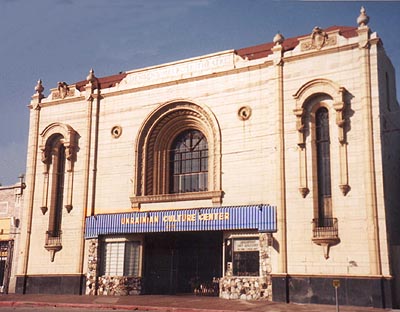 27. Ukrainian Culture Center/Jensen's Melrose Theatre
27. Ukrainian Culture Center/Jensen's Melrose Theatre
1924
4315 Melrose Ave, East Hollywood
The
Ukrainian Culture Center of Los Angeles opened in 1961 to serve what was then a strong ethnic enclave - a Ukrainian church stands just four blocks east. Today it is a popular venue for quinceañeras. The Grammy-winning indie rock band Arcade Fire played a "secret" show here in February 2011, prior to picking up their award.
This building was built in 1924 as
"Jensen's Melrose Theatre" (one of a series of entertainment centers built by the Jensen brothers, whom
also built one on Sunset Blvd in Echo Park), built for what was then an upper-class neighborhood located next to what was then UCLA (University of California, Southern Extension, now the Los Angeles City College campus). It was one of the last silent movie theatres built in the country, and operated until 1959. Take a look at the top of the facade -- the original name of the building is etched in concrete!
Oh, maaan! That was one long-ass post! Guess it made up for the lack of MA blog posts in 2010...anyways, enjoy CicLAvia on Sunday, and refer to this post as a guide!
To download and print a copy of this tour guide to take with you on your ride on Sunday, please click here! (Go to File -> Print (PDF) in the Google Docs window)
 It may or may not be obvious that The Militant has an obsession with signage, but he was quite excited this past week upon doing his Militant Surveying missions that the under-construction Metro Expo Line has recently been sporting its 12-foot tall station pylon signs at several of its stops.
It may or may not be obvious that The Militant has an obsession with signage, but he was quite excited this past week upon doing his Militant Surveying missions that the under-construction Metro Expo Line has recently been sporting its 12-foot tall station pylon signs at several of its stops.




